
The flamebacks or goldenbacks are large woodpeckers which are resident breeders in tropical southern Asia. They derive their English names from their golden or crimson backs.

The black-rumped flameback, also known as the lesser golden-backed woodpecker or lesser goldenback, is a woodpecker found widely distributed in the Indian subcontinent. It is one of the few woodpeckers that are seen in urban areas. It has a characteristic rattling-whinnying call and an undulating flight. It is the only golden-backed woodpecker with a black throat and a black rump.
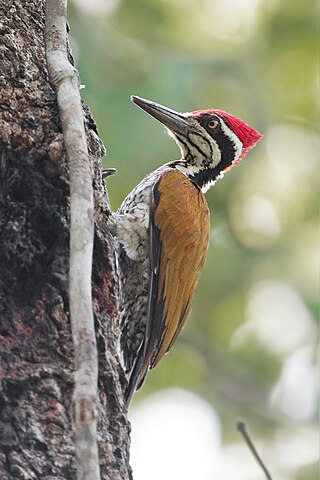
The greater flameback, also known as the greater goldenback or large golden-backed woodpecker, is a woodpecker species. It occurs widely in the northern Indian subcontinent, eastwards to southern China, the Malay Peninsula, Sumatra, western and central Java and northeast Borneo.

The lesser yellownape is a type of woodpecker which is a widespread and often common breeder in tropical and sub-tropical Asia, primarily the Indian subcontinent and Southeast Asia. It ranges from India, Bhutan, Nepal, Bangladesh and Sri Lanka eastwards to Thailand, Burma, Cambodia, Laos, Indonesia, Malaysia and Vietnam. Much of the scientific knowledge gathered about this species is sourced from formal studies in various parts of India.

Dryocopus is a genus of large powerful woodpeckers, typically 35–45 cm in length. It has representatives in North and South America, Europe, and Asia; some South American species are endangered. It was believed to be closely related to the American genus Campephilus, but it is part of a different lineage of woodpeckers altogether

The bay woodpecker is a species of bird in the family Picidae.

The Himalayan woodpecker is a species of bird in the family Picidae. It is found in the northern regions of the Indian subcontinent, primarily the Himalayas and some adjoining areas, and ranges across Afghanistan, India, Nepal, Bhutan and Pakistan. Its natural habitats are boreal forests and temperate forests. The International Union for Conservation of Nature has assessed its conservation status as being of "least concern".
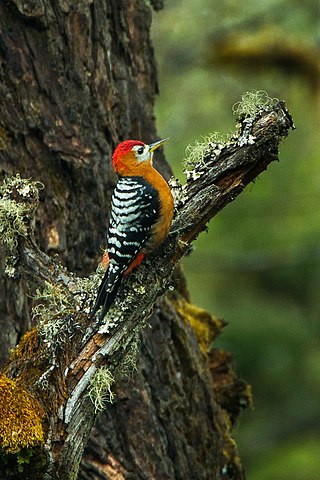
The rufous-bellied woodpecker or rufous-bellied sapsucker is a species of bird in the family Picidae. This woodpecker has a habit of making a series of small pits on the bark of trees leading to its being considered an Asiatic member of the sapsuckers in the past. It is found along the Himalayas in the Indian subcontinent and Southeast Asia, ranging across Bangladesh, Bhutan, Cambodia, Hong Kong, India, Korea, Myanmar, Nepal, Thailand, Manchuria, Ussuriland and Vietnam. Its natural habitats are subtropical or tropical moist lowland forests and subtropical or tropical moist montane forests.

The common flameback, also referred to as the common goldenback, is a small (28–30 cm), three-toed woodpecker in the family Picidae, found throughout South and Southeast Asia.
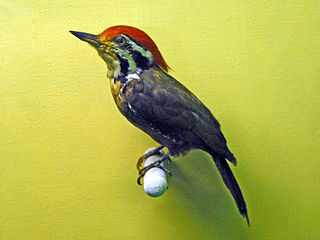
The olive-backed woodpecker is a species of bird in the woodpecker family Picidae that is found in Southeast Asia.
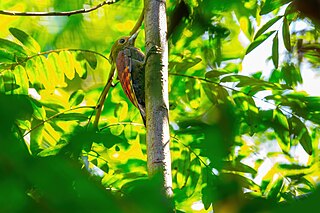
The pale-headed woodpecker is a species of bird in the family Picidae. It is found in Bangladesh, Bhutan, China, India, Laos, Myanmar, Nepal, Thailand, and Vietnam. Its natural habitats are subtropical or tropical dry forests and subtropical or tropical moist lowland forests. It is a bamboo specialist, and a montane bird.

The great slaty woodpecker is a species of bird in the family Picidae. It is found across the Indian Subcontinent and Southeast Asia. A unique and basically unmistakable bird, it is the largest known species of woodpecker.

Hodgson's treecreeper is a small passerine bird from the southern rim of the Himalayas. Its specific distinctness from the common treecreeper was recently validated.

The buff-spotted flameback is a species of bird in the family Picidae. It is found on the Philippine islands of Bohol, Leyte, Samar, Biliran, Panaon, Mindanao, Basilan, and Samal. Along with the other Philippine species, Yellow-faced flameback, Luzon flameback, Red-headed flameback, it was formerly conspecific greater flameback
The spot-throated flameback is a species of bird in the family Picidae. It is endemic to the Philippines only being found in the province of Palawan in the islands of Balabac, Busuanga and Calamian and mainland Palawan.. It is sometimes considered a subspecies of the common flameback.It is found in moist lowland forests including primary, secondary and even plantations and clearings provided there are still standing trees. It is threatened by habitat loss.

The Luzon flameback is a species of bird in the family Picidae. It is found on the northern islands of Luzon, Polillo, Catanduanes and Marinduque, Philippines. It is sometimes considered a subspecies of the greater flameback.

The yellow-faced flameback is a species of bird in the family Picidae. It is found on the Philippine islands of Negros and Panay. It is extinct on Guimaras, Masbate, and Ticao (extinct). It is one of the most spectacular woodpeckers with its bright yellow head and crimson red back. It is sometimes considered a subspecies of the greater flameback. It is found in moist lowland forests including primary, secondary and even plantations and clearings provided there are still standing trees. It is the rarest woodpecker in the country and it is threatened by habitat loss.
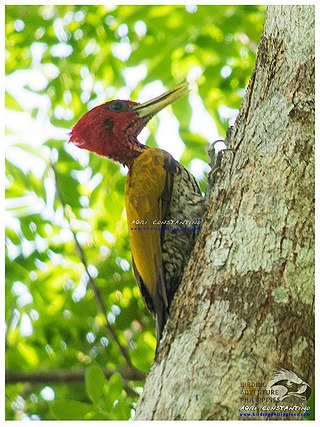
The red-headed flameback is a species of bird in the family Picidae. It is endemic to the Philippines only being found in the region of Palawan in the islands of Balabac, mainland Palawan, Busuanga and Calamian. It is one of the most spectacular flamebacks with its bright red head and yellow-green back. It is sometimes considered a subspecies of the greater flameback. It is found in moist lowland forests including primary, secondary and even plantations and clearings provided there are still standing trees. It is threatened by habitat loss.

The Red-backed flameback, Lesser Sri Lanka flameback, Sri Lanka red-backed woodpecker or Ceylon red-backed woodpecker is a species of bird in the family Picidae. It is endemic to Sri Lanka, only absent in the far-north. It is sometimes considered a subspecies of the Black-rumped flameback.




















